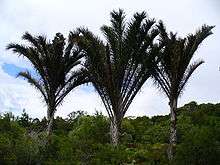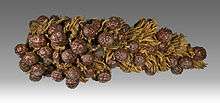Raffia palm
| Raffia palm | |
|---|---|
 | |
| Scientific classification | |
| Kingdom: | Plantae |
| (unranked): | Angiosperms |
| (unranked): | Monocots |
| (unranked): | Commelinids |
| Order: | Arecales |
| Family: | Arecaceae |
| Subfamily: | Calamoideae |
| Tribe: | Calameae |
| Genus: | Raphia P.Beauv. |
The Raffia palms (Raphia) are a genus of about twenty species of palms native to tropical regions of Africa, and especially Madagascar, with one species (R. taedigera) also occurring in Central and South America.[1] Raphia taedigera are the source of raffia fibers, which are the veins of the leaves, and produces a fruit called "brazilia pods", "uxi nuts" or "uxi pods".[2]
They grow up to 16 m (52.5 ft) tall and are remarkable for their compound pinnate leaves, the longest in the plant kingdom; leaves of R. regalis up to 25 m (82.38 ft) long[3] and 3 m (9.84 ft) wide are known. The plants are either monocarpic, flowering once and then dying after the seeds are mature, or hapaxanthic. Some species have individual stems which die after fruiting, but have a root system which remains alive and sends up new stems which fruit.
Species

- Raphia africana Otedoh - Nigeria, Cameroon
- Raphia australis Oberm. & Strey - Mozambique, South Africa
- Raphia farinifera (Gaertn.) Hyl. - Africa from Senegal to Tanzania, south to Mozambique and Zimbabwe
- Raphia gentiliana De Wild. - Zaïre, Central African Republic
- Raphia hookeri G.Mann & H.Wendl. - western and central Africa from Liberia to Angola
- Raphia laurentii De Wild. - Angola, Zaïre, Central African Republic
- Raphia longiflora G.Mann & H.Wendl. - from Nigeria to Zaïre
- Raphia mambillensis Otedoh - Nigeria, Cameroon, Central African Republic, Sudan
- Raphia mannii Becc. - Nigeria, Bioko
- Raphia matombe De Wild. - Cabinda, Zaïre
- Raphia monbuttorum Drude - Nigeria, Cameroon, Chad, Central African Republic, South Sudan
- Raphia palma-pinus (Gaertn.) Hutch. - western Africa from Liberia to Cabinda
- Raphia regalis Becc. - central Africa from Nigeria to Angola
- Raphia rostrata Burret - Cabinda, Zaïre
- Raphia ruwenzorica Otedoh - eastern Zaïre, Rwanda, Burundi
- Raphia sese De Wild. - Zaïre
- Raphia sudanica A. Chev. - western Africa from Senegal to Cameroon
- Raphia taedigera (Mart.) Mart. - Nigeria, Cameroon, Central America (Costa Rica, Nicaragua, Panama), South America (Colombia, Pará State of Brazil)
- Raphia textilis Welw. - Cabinda, Zaïre, Gabon, Angola
- Raphia vinifera P. Beauv. - western Africa from Zaïre to Benin
Cultivation and uses
Fibre
Raffia fibre is widely used throughout the world. It is used in twine, rope, baskets, placemats, hats, shoes, and textile.
The fibre is produced from the membrane on the underside of each individual frond leaf. The membrane is taken off to create a long thin fibre which can be dyed and woven as a textile into products ranging from hats to shoes to decorative mats.
Plain raffia fibres are exported and used as garden ties or as a "natural" string in many countries. Especially when one wishes to graft trees, raffia is used to hold plant parts together as a more "natural" rope.
Raffia fibres have many uses, especially in the area of textiles and in construction. In their local environments, they are used for ropes, sticks and supporting beams, and various roof coverings are made out of its fibrous branches and leaves.
Raffia wine
Raffia palm also provides an important cultural drink. The sap contains sugars. It is traditionally collected by cutting a box in the top of the palm and suspending a large gourd to collect the milky white liquid. Unlike oil palms, this process kills the tree. Sap from both the raffia and oil palms can be allowed to ferment over a few days. When first collected from the tree, it is sweet and appears slightly carbonated. As it ages more sugar is converted. The sap is usually called wine. The raffia wine tends to be sweeter at any age when compared to oil palm wine. Both kinds of palm wine can also be distilled into strong liquors, such as Ogogoro. Traditionally in some cultures where raffia and/or oil palm are locally available, guests and spirits are offered these drinks from the palm trees.
The raffia palm is important in societies such as that of the Province of Bohol in the Philippines, Kuba of Democratic Republic of the Congo, Nso of Cameroon, the Igbo and Ibibio/Annang of Southeastern Nigeria, the Urhobo and Ijaw people of Niger delta Nigeria and the Yoruba of southwestern Nigeria, among several other West African ethnic nations.
 Removing the fibrous inner layer of the palm frond leaves as a first step in making raffia rope in Bandundu Province, Democratic Republic of the Congo.
Removing the fibrous inner layer of the palm frond leaves as a first step in making raffia rope in Bandundu Province, Democratic Republic of the Congo. Palm frond fibers are rolled together for added strength before they are finally dried.
Palm frond fibers are rolled together for added strength before they are finally dried. Raffia is woven to make the traditional Munganji dancer suit used in Bapende ceremonies in the Gungu region of Bandundu Province, Democratic Republic of the Congo
Raffia is woven to make the traditional Munganji dancer suit used in Bapende ceremonies in the Gungu region of Bandundu Province, Democratic Republic of the Congo
References
- ↑ Kew World Checklist of Selected Plant Families
- ↑ Tucker, A.; Redford, A.; Scher, J.; Trice, M. (2010). "Raphia taedigera". Dried Botanical ID. Fort Collins, CO: Delaware State University, Identification Technology Program, CPHST, PPQ, APHIS, USDA. Retrieved 7/10/2016. Check date values in:
|access-date=(help) - ↑ Hallé, F. 1977. The longest leaf in palms? Principes 21: 18.
External links
- Kew palms checklist: Raphia
- Sorting Raphia names
- PACSOA: Raphia
- South Africa plants: Raphia australis
- Fairchild Tropical Botanic Garden: Raphia
- Raphia articles
- Palm Pedia

